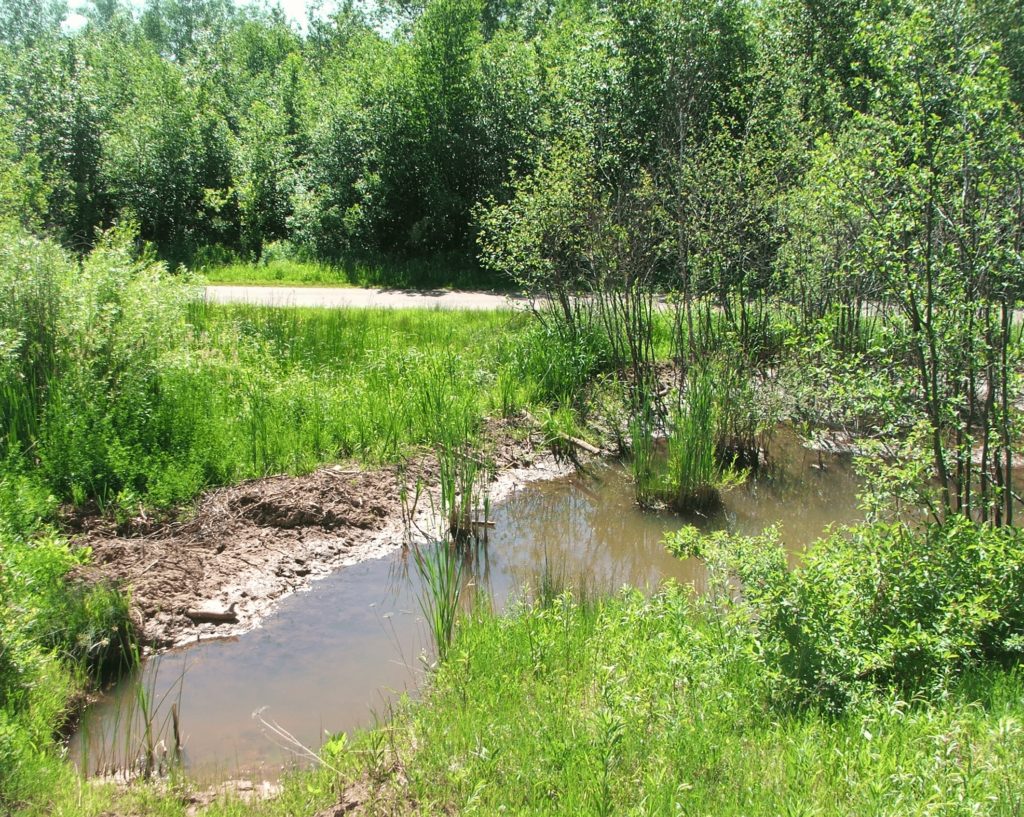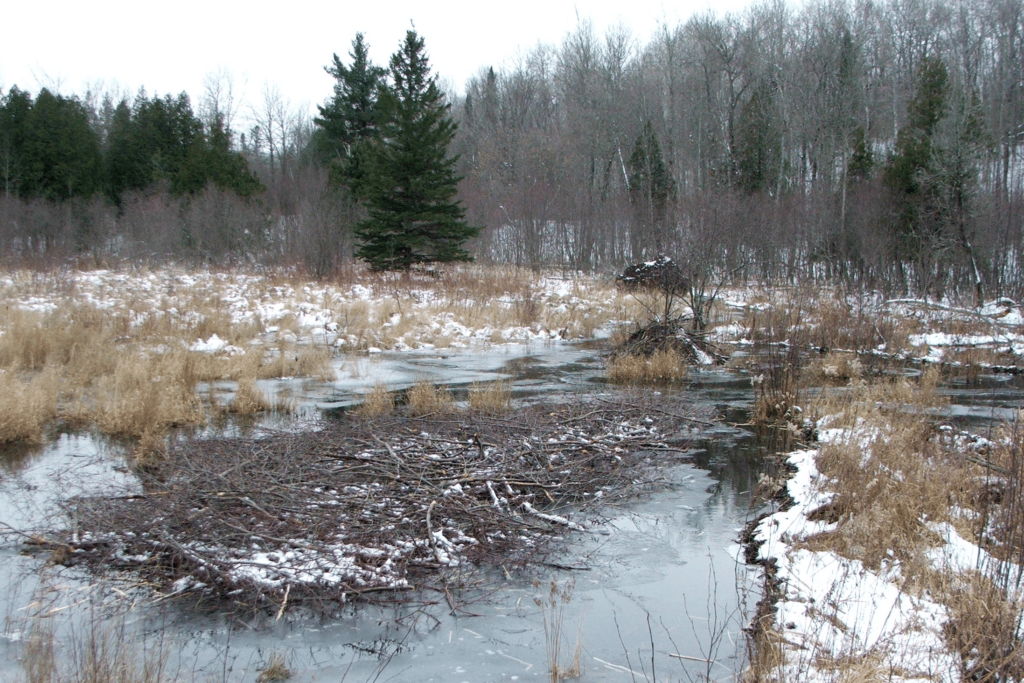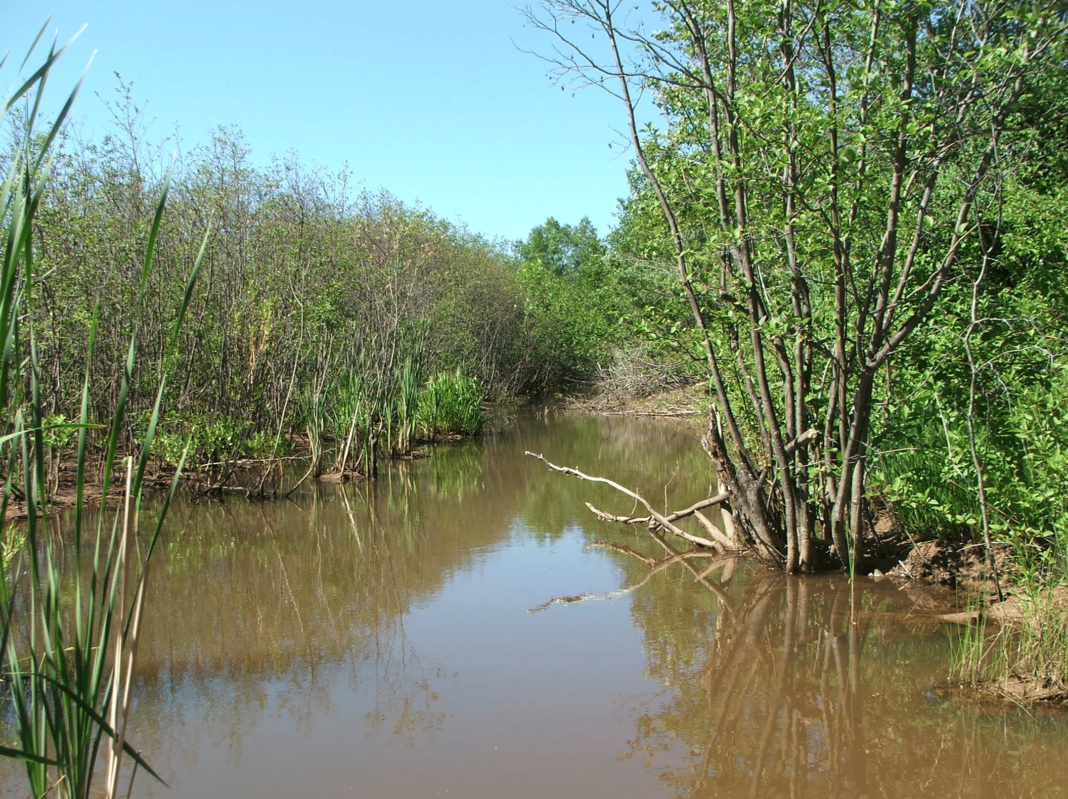This past March, users of the Duluth, Winnipeg, and Pacific (DWP) trail in West Duluth noticed a beaver dam being built in the drainage ditch adjacent to the trail. A line of mud only a few inches tall at first, within a few weeks the dam had grown to two feet high. The drainage ditch backed up behind the dam and the water deepened, essentially forming a narrow pond parallel to the DWP, approximately fifteen feet wide and two hundred feet long.
The location was unusual, because the water in the pond came primarily from seasonal hillside runoff, rather than a constantly flowing stream. No other beaver colonies were nearby. The black-topped DWP trail, used by pedestrians, bikers, and dog-walkers, was busy enough that one might expect beavers to avoid it. Instead, they settled in and went to work. When water began spilling onto the DWP itself, trail users alerted the city to the situation.
According to Jim Filby Williams, the city’s Director of Parks, Properties, and Libraries, this is the second year that beavers have been active at this location. In the spring of 2020, city workers were able to drain the pond by cutting through the beaver dam with hand tools. This spring, however, “beaver activity really accelerated.” The city hired a professional trapper, who removed a single beaver from the pond.
“The trapper was confident that it was the only one in that area,” Filby Williams told me in an email on June 14. However, when trees continued to be chewed down around the pond and the dam continued to grow, the trapper concluded that another beaver had moved into the abandoned pond. Filby Williams said that “they have been contacted again this month and are working on trapping the area.”

When I visited the location on June 16, though the pond is mere feet from the trail, I found it mostly hidden behind a dense screen of buckthorn and tag alder. The head of the dam is the most open and accessible point. If you park on Greene Street and follow the DWP west, the dam is located about 200 feet past the double bridges (one bridge for snowmobiles, one for people). It’s probably a quarter-mile walk. The dam may be easy to miss among the grass and vegetation.
During my visit, I noticed that the water level had dropped considerably, leaving mud flats all around the edges of the impoundment. The mud of the dam was baked hard by the sun, and the water in the pond was brown and stagnant. I speculated that the beavers might leave voluntarily if conditions continued to dry out—they needed deep water to survive.
The DWP dam was the latest of approximately two dozen dams and lodges I had seen over the past year. I had expanded my walking excursions in response to Covid, and sometimes it seemed like there was scarcely a waterway in Duluth or Superior that was free of beavers.
• Amity Creek is dammed below Vermilion Road, where it flowed freely only a few years ago. Trees have been chewed down all along Vermilion and surrounding hillsides. This past winter, neighborhood kids converted the beaver pond into a skating rink.
• The waterfront trail between Boyscout Landing and Perch Lake, which follows the old Lake Superior and Mississippi Railroad line along the St. Louis River, welcomed a new colony of beavers this past year. A new lodge has been built on the riverbank, and a significant swath of big aspen trees has been felled on the hillside. Trees are lying every which way along the river.
• The new River Route section of the Cross City Trail, which opened last fall, passes through beaver habitat. Unruffled by the ships, railroads, interstate highways, paper mills, and power plants in the vicinity, the beavers live in lodges among the cattails and the causeways, from which they venture forth at night to gnaw on nearby aspen. Many trees along the River Route have been reduced to pointed stubs.
On June 10, I spoke with Minnesota Department of Natural Resources Area Wildlife Manager Chris Balzer, who is responsible for wildlife issues in Pine County, Carlton County, and the southern half of St. Louis County. I asked Balzer if he had noticed any increase in the beaver population lately. He said no, adding that he didn’t believe there was a great deal of room for the beaver population to grow.
“We’ve been pretty well-saturated with beaver,” said Balzer. “You know, there’s only so much habitat … Most good habitats would have evidence of beaver. They might come and go a little bit—colonies will stay for a while and utilize the easiest and best food sources, along the water’s edge, and then they move on for a little while. But then all those trees and shrubs that they cut down grow back, and five years later it’s prime beaver habitat again, and they move back in. So there’s a little bit of that, but for the most part, in pretty much any water body you go on, there’s an abundance of beaver.”
Until about fifteen years earlier, Balzer said, the DNR had conducted annual aerial surveys to count beaver lodges, “particularly the beaver lodges that have the winter food cache out in front of them.” In the fall, beavers stockpile sticks and vegetation in the pond near their lodge, which they eat during the winter. “We know that’s an active beaver colony. We can see that from the air,” said Balzer.
What the DNR discovered, however, was that the beaver population didn’t change much. “They found out, over the years, that … beaver are kind of everywhere, and they’re always there,” said Balzer with a laugh. “There wasn’t a major change, and it was a pretty expensive survey to fly in a plane several days or a week, all over the state, so they discontinued it based on those factors.”

Dam neighbors across the bridge
The story was similar in Wisconsin. I found beaver sign everywhere I went—the Pokegama River, the Little Pokegama, nameless drainages in the Superior Municipal Forest. A new beaver lodge has materialized near a bridge on the Bear Creek Trail, and trees have been chewed down for several hundred feet upstream.
On June 11, I spoke with Greg Kessler, wildlife manager with the Wisconsin DNR. Kessler said that, like Minnesota, the WIDNR has discontinued aerial surveys of beaver populations, due to the high cost. Today, the WIDNR relies on trapper surveys to make population estimates. Kessler said that, anecdotally, he had heard people talking about more beavers being around.
“Talking to trappers and property owners, I would confirm that that is my impression … that there’s a lot more beaver activity, especially this last year or two,” said Kessler. “Somebody just told me about [the Bear Creek] drainage leading into the estuary that’s just loaded with beaver, just outside the [Superior] city limits.”
Kessler said that extremely low fur prices were probably contributing to a rise in beaver numbers, because nobody is trapping them. “If fur prices come back, trappers will get out there … You know, they never make a ton of money in today’s day and age, but at least they [will be able to] pay for their activity versus now, when you literally can’t make enough to pay for your gas.”
When I asked Kessler what an average beaver pelt was worth today, he said a friend had recently sold one for $5. “The prices are so low right now [that] you just have to do it [for] other reasons beyond making any kind of money or even making your expenses. Right now, trapping for beaver is primarily being done by a few people recreationally, just because they enjoy doing it, [or] because beaver are causing a problem of some sort.”

Out, dammed spot
Despite its many waterways, the City of Duluth does not have a formal policy regarding beaver, preferring to address issues on a case-by-case basis. According to Director Filby Williams, “Beavers play an important role in our ecosystem and so we try and balance the natural environment and the impact it has on our urban community.” He said that, other than along the DWP, no beavers were being trapped within the city’s park system. “Waabizheshikana Trail, Bayfront [Park] and Park Point are areas that we monitor for activity,” he wrote. “I’m trying to learn more about the drainage on the new section of the Cross City Trail between 40th Ave West and Recycle Way. There is beaver activity in that area and I’m trying to learn more about how it’s impacting the area.”
With regard to the DWP, the city might decide to do more than just trap the beavers. “We may even need to consider removing the dam with mechanized equipment so that it is less appealing for another beaver to move in,” wrote Filby Williams.
Reached for comment at the dam, a beaver who identified himself only as Biff told the Monitor, “This is ridiculous. We’re trying to live in a ditch and eat aspen. There’s no harm in that. Do you people even like aspen? You tell your mayor—” At this point, the call was abruptly disconnected.

___________________________________________
Cover photo: DWP beaver pond, June 16, 2021. Credit: John Ramos





